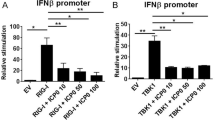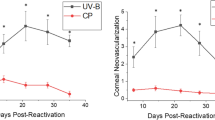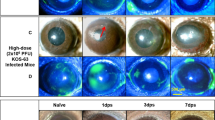Abstract
Herpes simplex virus type 1 (HSV-1) is a leading cause of infectious blindness. Current treatments for HSV-1 do not eliminate the virus from the site of infection or latent reservoirs in the trigeminal ganglia. Here, we target HSV-1 genomes directly using mRNA-carrying lentiviral particles that simultaneously deliver SpCas9 mRNA and viral-gene-targeting guide RNAs (designated HSV-1-erasing lentiviral particles, termed HELP). We show that HELP efficiently blocks HSV-1 replication and the occurrence of herpetic stromal keratitis (HSK) in three different infection models. HELP was capable of eliminating the viral reservoir via retrograde transport from corneas to trigeminal ganglia. Additionally, HELP inhibited viral replication in human-derived corneas without causing off-target effects, as determined by whole-genome sequencing. These results support the potential clinical utility of HELP for treating refractory HSK.
This is a preview of subscription content, access via your institution
Access options
Access Nature and 54 other Nature Portfolio journals
Get Nature+, our best-value online-access subscription
$29.99 / 30 days
cancel any time
Subscribe to this journal
Receive 12 print issues and online access
$209.00 per year
only $17.42 per issue
Buy this article
- Purchase on Springer Link
- Instant access to full article PDF
Prices may be subject to local taxes which are calculated during checkout






Similar content being viewed by others
Data availability
Data generated or analyzed during this study are available from the corresponding author on reasonable request. The deep-sequencing and whole-genome sequencing data are available at NCBI BioProject. The BioProject IDs are PRJNA668071 and PRJNA668060, respectively. Source data are provided with this paper.
References
Liesegang, T. J. Herpes simplex virus epidemiology and ocular importance. Cornea 20, 1–13 (2001).
Paludan, S. R., Bowie, A. G., Horan, K. A. & Fitzgerald, K. A. Recognition of herpesviruses by the innate immune system. Nat. Rev. Immunol. 11, 143–154 (2011).
Bradshaw, M. J. & Venkatesan, A. Herpes simplex virus-1 encephalitis in adults: pathophysiology, diagnosis, and management. Neurotherapeutics 13, 493–508 (2016).
Farooq, A. V. & Shukla, D. Herpes simplex epithelial and stromal keratitis: an epidemiologic update. Surv. Ophthalmol. 57, 448–462 (2012).
Crumpacker, C. S. & Schaffer, P. A. New anti-HSV therapeutics target the helicase–primase complex. Nat. Med. 8, 327–328 (2002).
Remeijer, L. et al. Prevalence and clinical consequences of herpes simplex virus type 1 DNA in human cornea tissues. J. Infect. Dis. 200, 11–19 (2009).
Wang, L., Wang, R., Xu, C. & Zhou, H. Pathogenesis of herpes stromal keratitis: immune inflammatory response mediated by inflammatory regulators. Front. Immunol. 11, 766 (2020).
Awasthi, S. et al. Nucleoside-modified mRNA encoding HSV-2 glycoproteins C, D, and E prevents clinical and subclinical genital herpes. Sci. Immunol. 4, eaaw7083 (2019).
Bolland, S. & Pierce, S. K. Ups and downs in the search for a herpes simplex virus vaccine. eLife 4, e06883 (2015).
Vadlapudi, A. D., Vadlapatla, R. K. & Mitra, A. K. Update on emerging antivirals for the management of herpes simplex virus infections: a patenting perspective. Recent Pat. Antiinfect. Drug Discov. 8, 55–67 (2013).
Jiang, Y. C., Feng, H., Lin, Y. C. & Guo, X. R. New strategies against drug resistance to herpes simplex virus. Int. J. Oral Sci. 8, 1–6 (2016).
Schaeffer, H. J. et al. 9-(2-hydroxyethoxymethyl) guanine activity against viruses of the herpes group. Nature 272, 583–585 (1978).
Koganti, R., Yadavalli, T. & Shukla, D. Current and emerging therapies for ocular herpes simplex virus type-1 infections. Microorganisms 7, 429 (2019).
Crute, J. J. et al. Herpes simplex virus helicase–primase inhibitors are active in animal models of human disease. Nat. Med. 8, 386–391 (2002).
Kleymann, G. et al. New helicase–primase inhibitors as drug candidates for the treatment of herpes simplex disease. Nat. Med. 8, 392–398 (2002).
Jaishankar, D. et al. An off-target effect of BX795 blocks herpes simplex virus type 1 infection of the eye. Sci. Transl. Med. 10, eaan5861 (2018).
Nelson, C. E. et al. Long-term evaluation of AAV-CRISPR genome editing for Duchenne muscular dystrophy. Nat. Med. 25, 427–432 (2019).
Maeder, M. L. et al. Development of a gene-editing approach to restore vision loss in Leber congenital amaurosis type 10. Nat. Med. 25, 229–233 (2019).
Beyret, E. et al. Single-dose CRISPR–Cas9 therapy extends lifespan of mice with Hutchinson–Gilford progeria syndrome. Nat. Med. 25, 419–422 (2019).
Santiago-Fernandez, O. et al. Development of a CRISPR/Cas9-based therapy for Hutchinson–Gilford progeria syndrome. Nat. Med. 25, 423–426 (2019).
Lee, B. et al. Nanoparticle delivery of CRISPR into the brain rescues a mouse model of fragile X syndrome from exaggerated repetitive behaviours. Nat. Biomed. Eng. 2, 497–507 (2018).
Gao, X. et al. Treatment of autosomal dominant hearing loss by in vivo delivery of genome editing agents. Nature 553, 217–221 (2018).
Dash, P. K. et al. Sequential LASER ART and CRISPR treatments eliminate HIV-1 in a subset of infected humanized mice. Nat. Commun. 10, 2753 (2019).
de Buhr, H. & Lebbink, R. J. Harnessing CRISPR to combat human viral infections. Curr. Opin. Immunol. 54, 123–129 (2018).
Aubert, M. et al. In vivo disruption of latent HSV by designer endonuclease therapy. JCI Insight 1, e88468 (2016).
Aubert, M. et al. Gene editing and elimination of latent herpes simplex virus in vivo. Nat. Commun. 11, 4148 (2020).
van Diemen, F. R. et al. CRISPR/Cas9-mediated genome editing of herpesviruses limits productive and latent infections. PLoS Pathog. 12, e1005701 (2016).
Oh, H. S. et al. Herpesviral lytic gene functions render the viral genome susceptible to novel editing by CRISPR/Cas9. eLife 8, e51662 (2019).
Weerasooriya, S., DiScipio, K. A., Darwish, A. S., Bai, P. & Weller, S. K. Herpes simplex virus 1 ICP8 mutant lacking annealing activity is deficient for viral DNA replication. Proc. Natl Acad. Sci. USA 116, 1033–1042 (2019).
Weller, S. K. & Coen, D. M. Herpes simplex viruses: mechanisms of DNA replication. Cold Spring Harb. Perspect. Biol. 4, a013011 (2012).
Reinert, L. S. et al. Sensing of HSV-1 by the cGAS–STING pathway in microglia orchestrates antiviral defence in the CNS. Nat. Commun. 7, 13348 (2016).
Herpetic Eye Disease Study Group. Oral acyclovir for herpes simplex virus eye disease: effect on prevention of epithelial keratitis and stromal keratitis. Arch. Ophthalmol. 118, 1030–1036 (2000).
Kennedy, D. P. et al. Ocular herpes simplex virus type 1: is the cornea a reservoir for viral latency or a fast pit stop? Cornea 30, 251–259 (2011).
Newell, C. K., Martin, S., Sendele, D., Mercadal, C. M. & Rouse, B. T. Herpes simplex virus-induced stromal keratitis: role of T-lymphocyte subsets in immunopathology. J. Virol. 63, 769–775 (1989).
Stuart, P. M., Summers, B., Morris, J. E., Morrison, L. A. & Leib, D. A. CD8+ T cells control corneal disease following ocular infection with herpes simplex virus type 1. J. Gen. Virol. 85, 2055–2063 (2004).
Jeon, S., Rowe, A. M., Carroll, K. L., Harvey, S. A. K. & Hendricks, R. L. PD-L1/B7-H1 inhibits viral clearance by macrophages in HSV-1-infected corneas. J. Immunol. 200, 3711–3719 (2018).
Biswas, P. S. & Rouse, B. T. Early events in HSV keratitis—setting the stage for a blinding disease. Microbes Infect. 7, 799–810 (2005).
Bae, S., Park, J. & Kim, J.-S. Cas-OFFinder: a fast and versatile algorithm that searches for potential off-target sites of Cas9 RNA-guided endonucleases. Bioinformatics 30, 1473–1475 (2014).
Sarah, B., Ibtissam, H., Mohammed, B., Hasna, S. & Abdeljalil, M. Intrastromal injection of bevacizumab in the management of corneal neovascularization: about 25 eyes. J. Ophthalmol. 2016, 6084270 (2016).
Berrozpe-Villabona, C. et al. Intrastromal bevacizumab injection for corneal neovascularization in herpetic stromal keratitis. J. Fr. Ophtalmol. 38, 776–777 (2015).
Sharma, N. et al. Management algorithm for fungal keratitis: the TST (topical, systemic, and targeted therapy) protocol. Cornea 38, 141–145 (2019).
Narayana, S. et al. Mycotic antimicrobial localized injection: a randomized clinical trial evaluating intrastromal injection of voriconazole. Ophthalmology 126, 1084–1089 (2019).
Koelle, D. M. et al. Tegument-specific, virus-reactive CD4 T cells localize to the cornea in herpes simplex virus interstitial keratitis in humans. J. Virol. 74, 10930–10938 (2000).
Maertzdorf, J., Verjans, G. M., Remeijer, L., van der Kooi, A. & Osterhaus, A. D. Restricted T cell receptor β-chain variable region protein use by cornea-derived CD4+ and CD8+ herpes simplex virus-specific T cells in patients with herpetic stromal keratitis. J. Infect. Dis. 187, 550–558 (2003).
Okinaga, S. Shedding of herpes simplex virus type 1 into tears and saliva in healthy Japanese adults. Kurume Med. J. 47, 273–277 (2000).
Kobayashi, K. et al. Pseudotyped lentiviral vectors for retrograde gene delivery into target brain regions. Front. Neuroanat. 11, 65 (2017).
Arriagada, G. Retroviruses and microtubule-associated motor proteins. Cell. Microbiol. 19, e12759 (2017).
Kato, S. et al. Enhancement of the transduction efficiency of a lentiviral vector for neuron-specific retrograde gene delivery through the point mutation of fusion glycoprotein type E. J. Neurosci. Methods 311, 147–155 (2019).
Acknowledgements
We thank F. Zhang (MIT, USA) for reading and commenting on our manuscript. The work was supported by grants from the National Natural Science Foundation of China (31971364), the Pujiang Talent Project of Shanghai (18PJ1404500), the Natural Science Foundation of Shanghai (18ZR1419300) and startup funding from the Shanghai Center for Systems Biomedicine, Shanghai Jiao Tong University (WF220441504) to Y.C. and by the National Natural Science Foundation of China (81970766 and 81670818), the Shanghai Rising-Star Program (18QA1401100), the Shanghai Innovation Development Program (2020779) and the Shanghai Key Clinical Research Program (SHDC2020CR3052B) to J.H. S.R.P. is supported by the European Research Council (ERC-AdG ENVISION; 786602).
Author information
Authors and Affiliations
Contributions
D.Y., S.L., J.H. and Y.C. conceptualized the study and designed the experiments; D.Y., S.L., D.W., Y.D., H.J. and X.Z. performed the experiments; S.R.P. provided the HSV-1 strains and facilitated building the mouse HSK model; all the authors analyzed the data; D.Y., S.L. and Y.C. wrote the manuscript with help from all the authors.
Corresponding authors
Ethics declarations
Competing interests
The authors declare no competing interests.
Additional information
Peer review information Nature Biotechnology thanks Paul R. Kinchington and the other, anonymous, reviewer(s) for their contribution to the peer review of this work.
Publisher’s note Springer Nature remains neutral with regard to jurisdictional claims in published maps and institutional affiliations.
Supplementary information
Supplementary Information
Supplementary Figs. 1–20 and Tables 1–5.
Source data
Source Data Fig. 1
Statistical source data.
Source Data Fig. 2
Statistical source data.
Source Data Fig. 3
Statistical source data.
Source Data Fig. 4
Statistical source data.
Source Data Fig. 5
Statistical source data.
Source Data Fig. 6
Statistical source data.
Source Data Fig. 6
Unprocessed western blots.
Rights and permissions
About this article
Cite this article
Yin, D., Ling, S., Wang, D. et al. Targeting herpes simplex virus with CRISPR–Cas9 cures herpetic stromal keratitis in mice. Nat Biotechnol 39, 567–577 (2021). https://doi.org/10.1038/s41587-020-00781-8
Received:
Accepted:
Published:
Issue Date:
DOI: https://doi.org/10.1038/s41587-020-00781-8
This article is cited by
-
Technologies of gene editing and related clinical trials for the treatment of genetic and acquired diseases: a systematic review
Egyptian Journal of Medical Human Genetics (2024)
-
UVB induced reactivation leads to HSV1 in the corneas of virtually all latently infected mice and requires STING to develop corneal disease
Scientific Reports (2024)
-
Cholesterol-binding motifs in STING that control endoplasmic reticulum retention mediate anti-tumoral activity of cholesterol-lowering compounds
Nature Communications (2024)
-
Recent advances in therapeutic CRISPR-Cas9 genome editing: mechanisms and applications
Molecular Biomedicine (2023)
-
Advances in CRISPR therapeutics
Nature Reviews Nephrology (2023)



